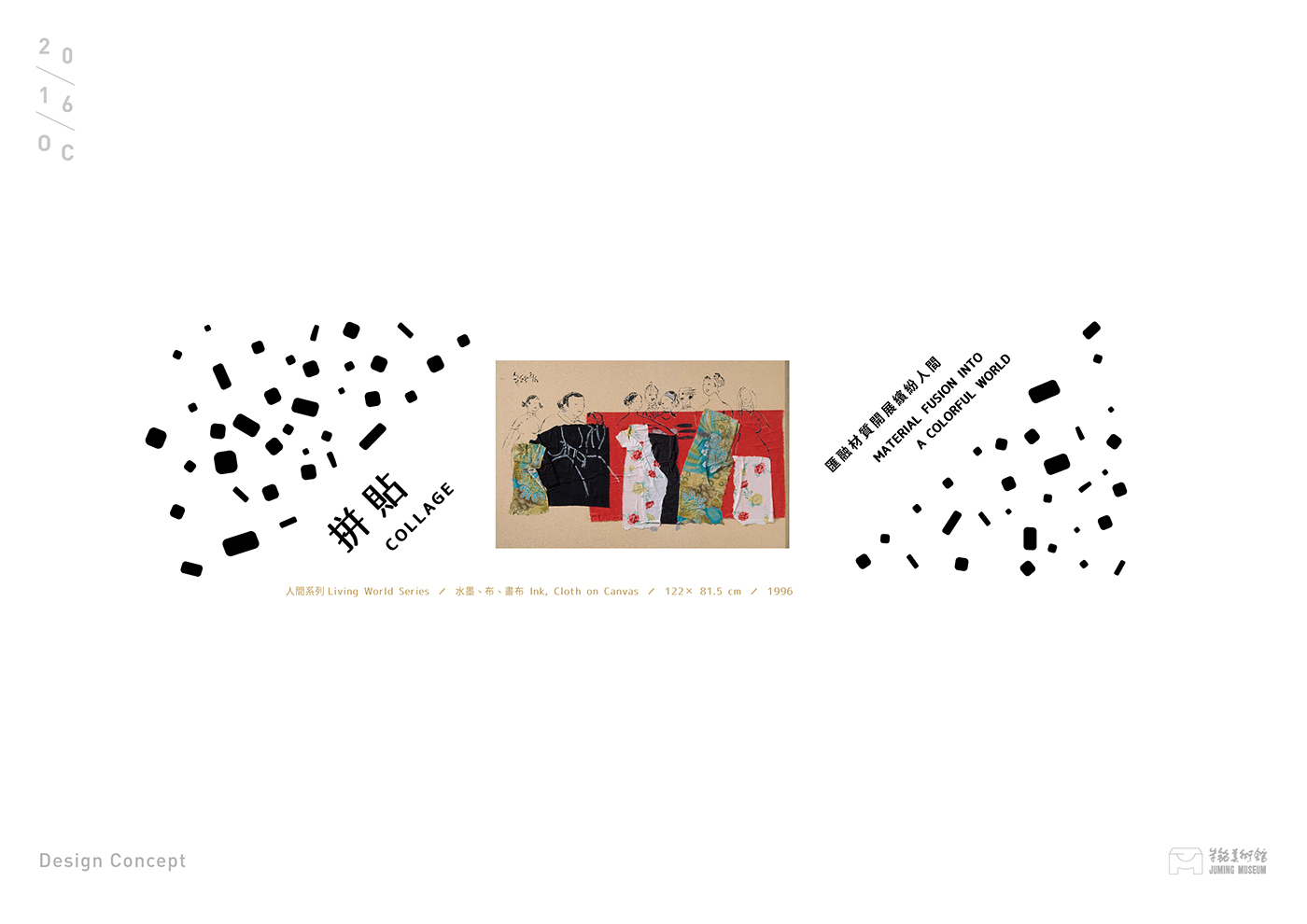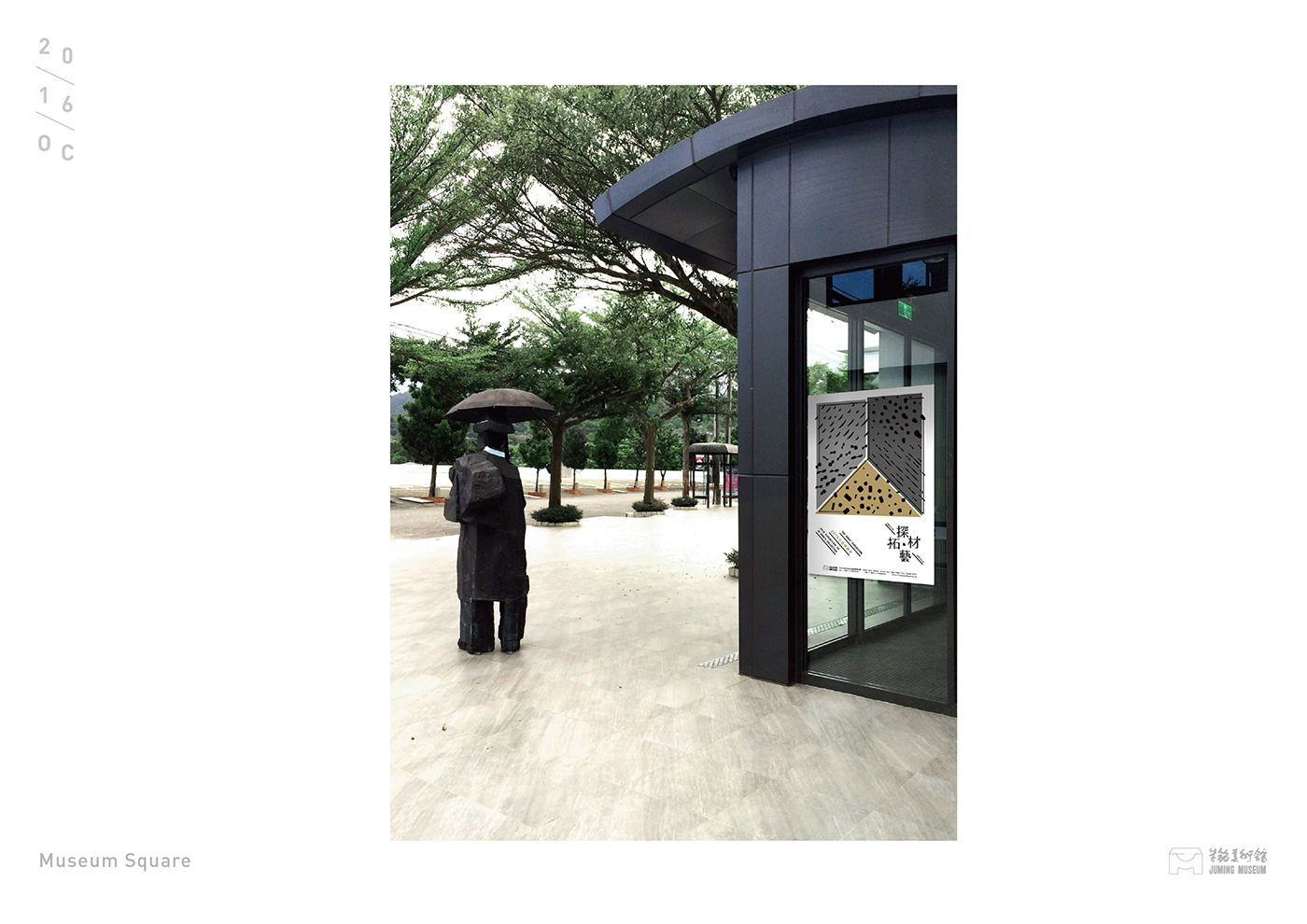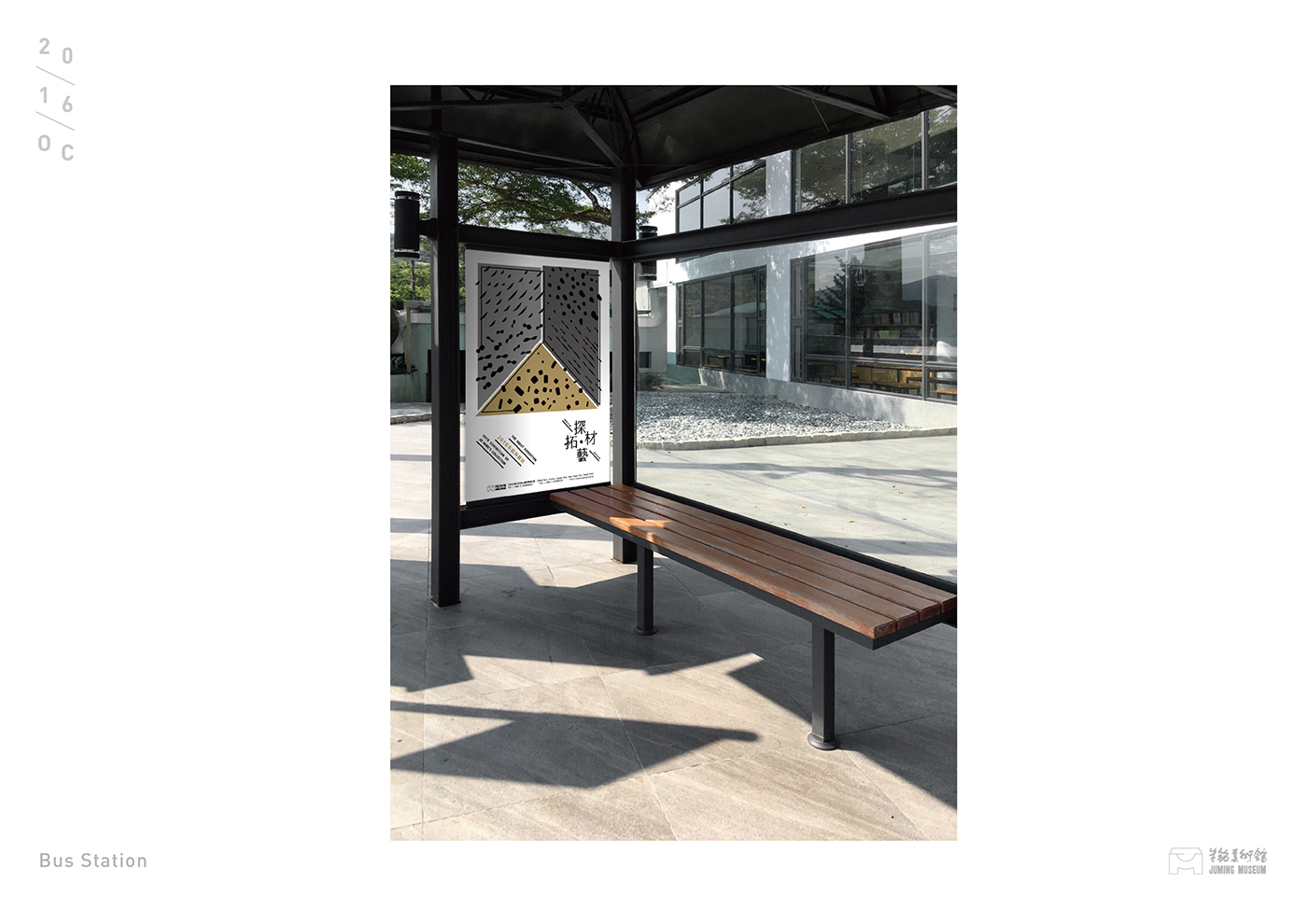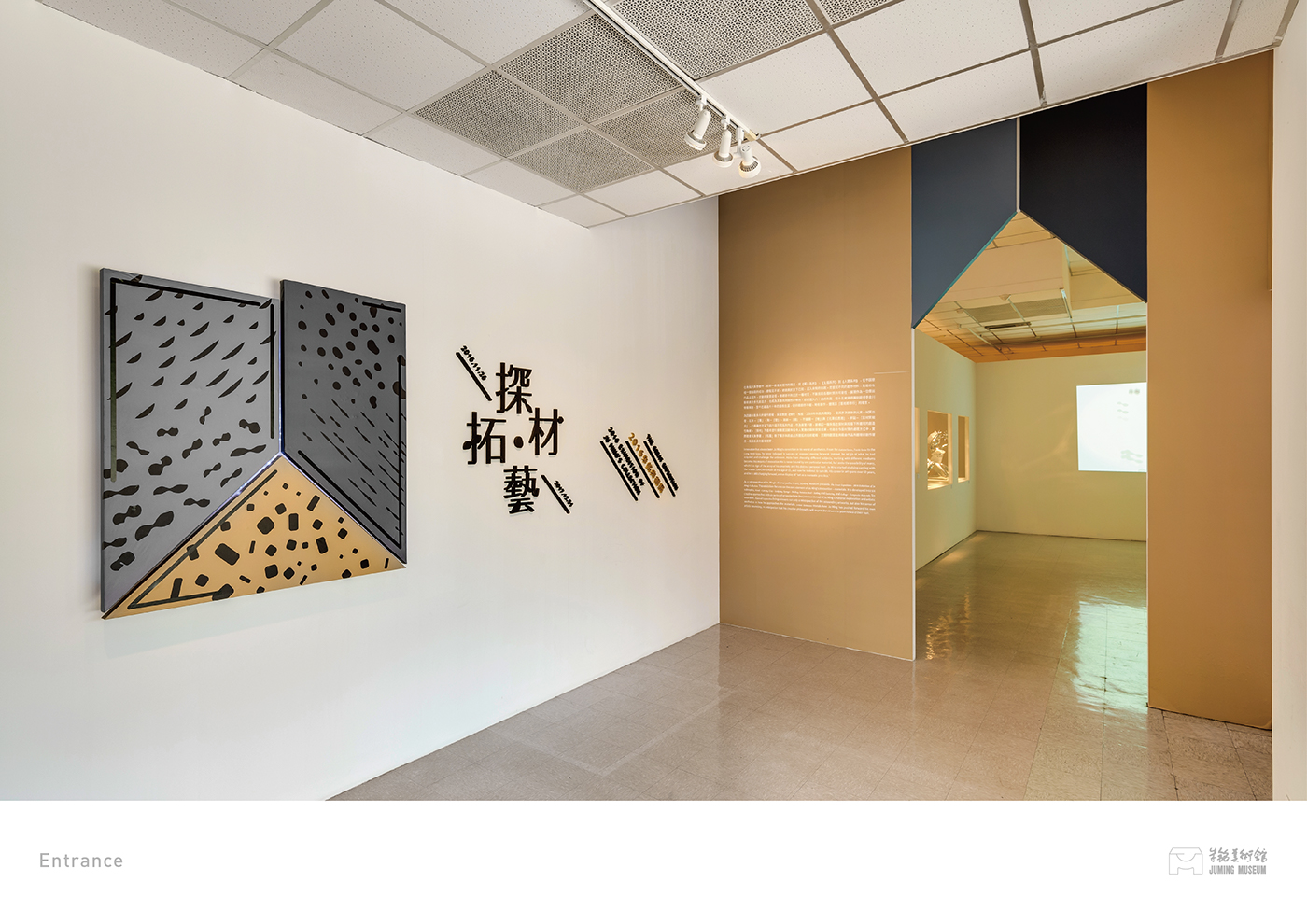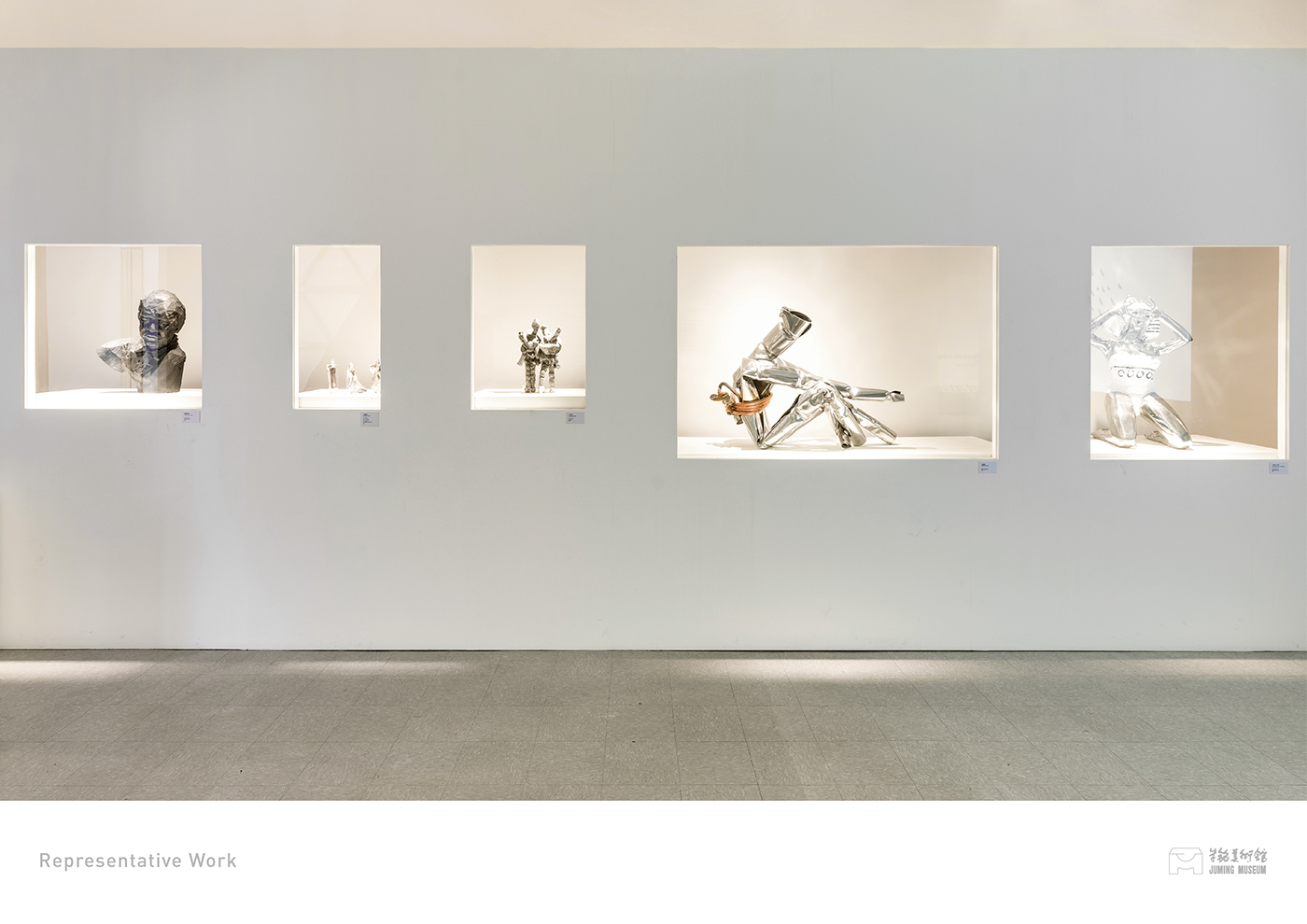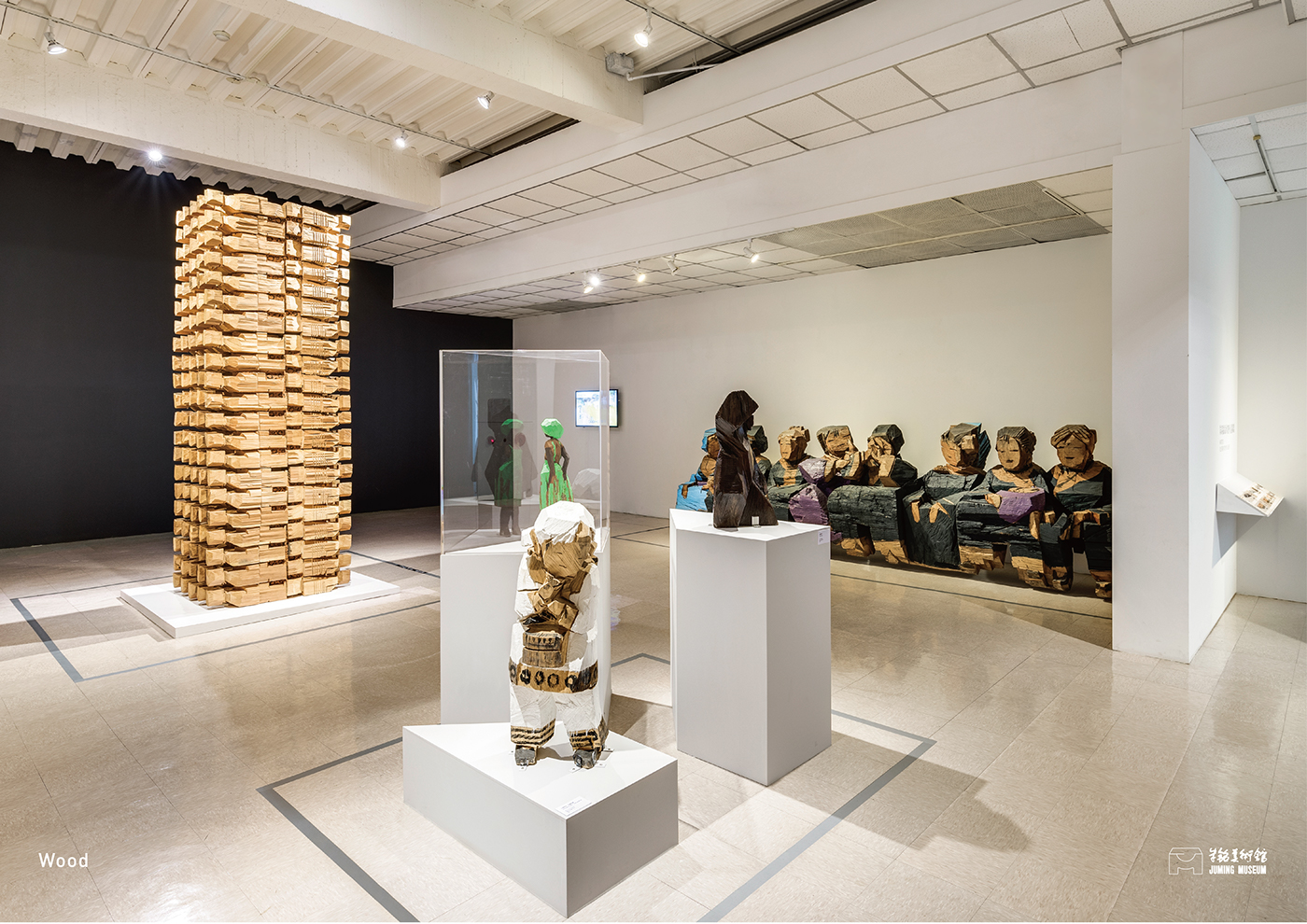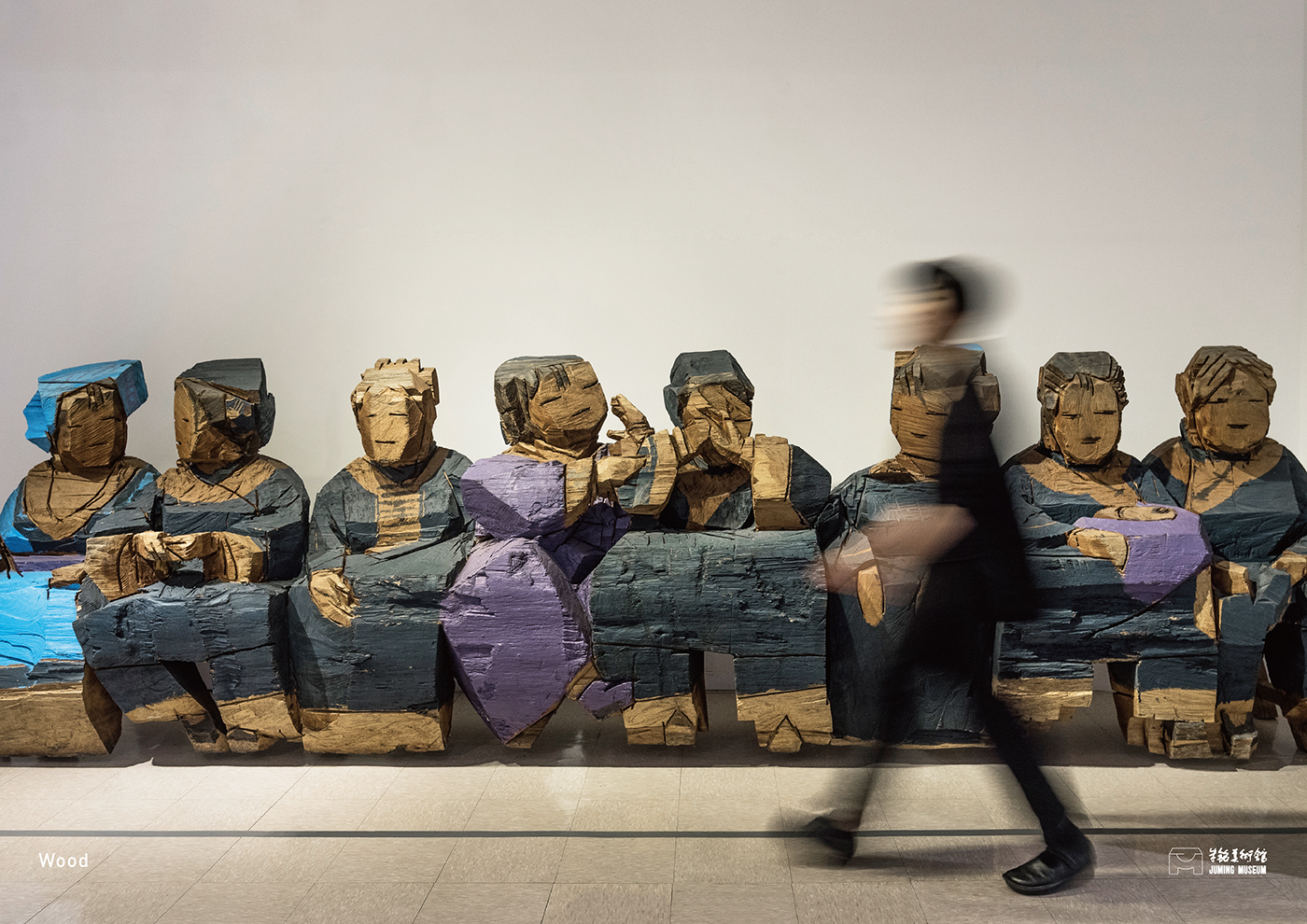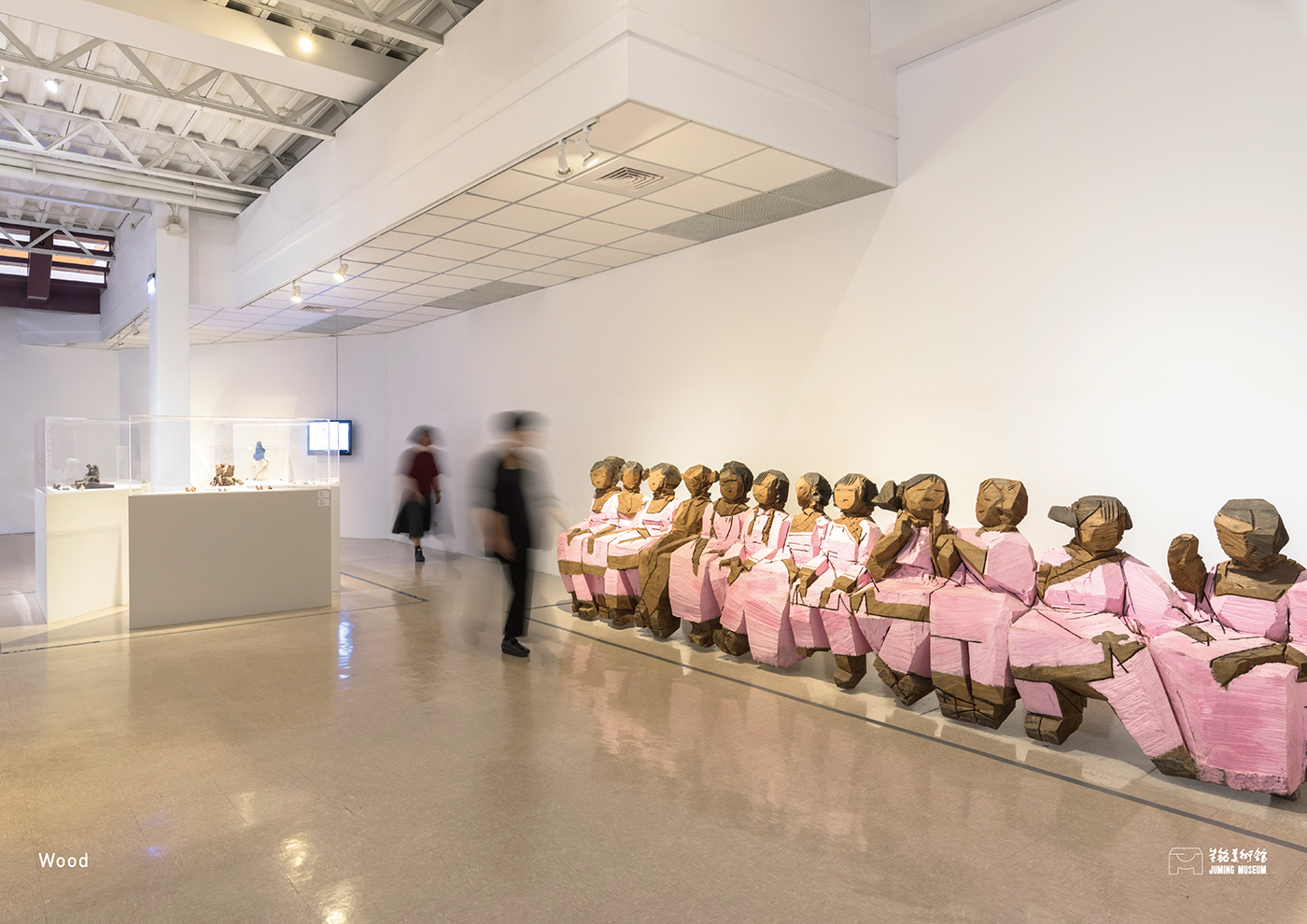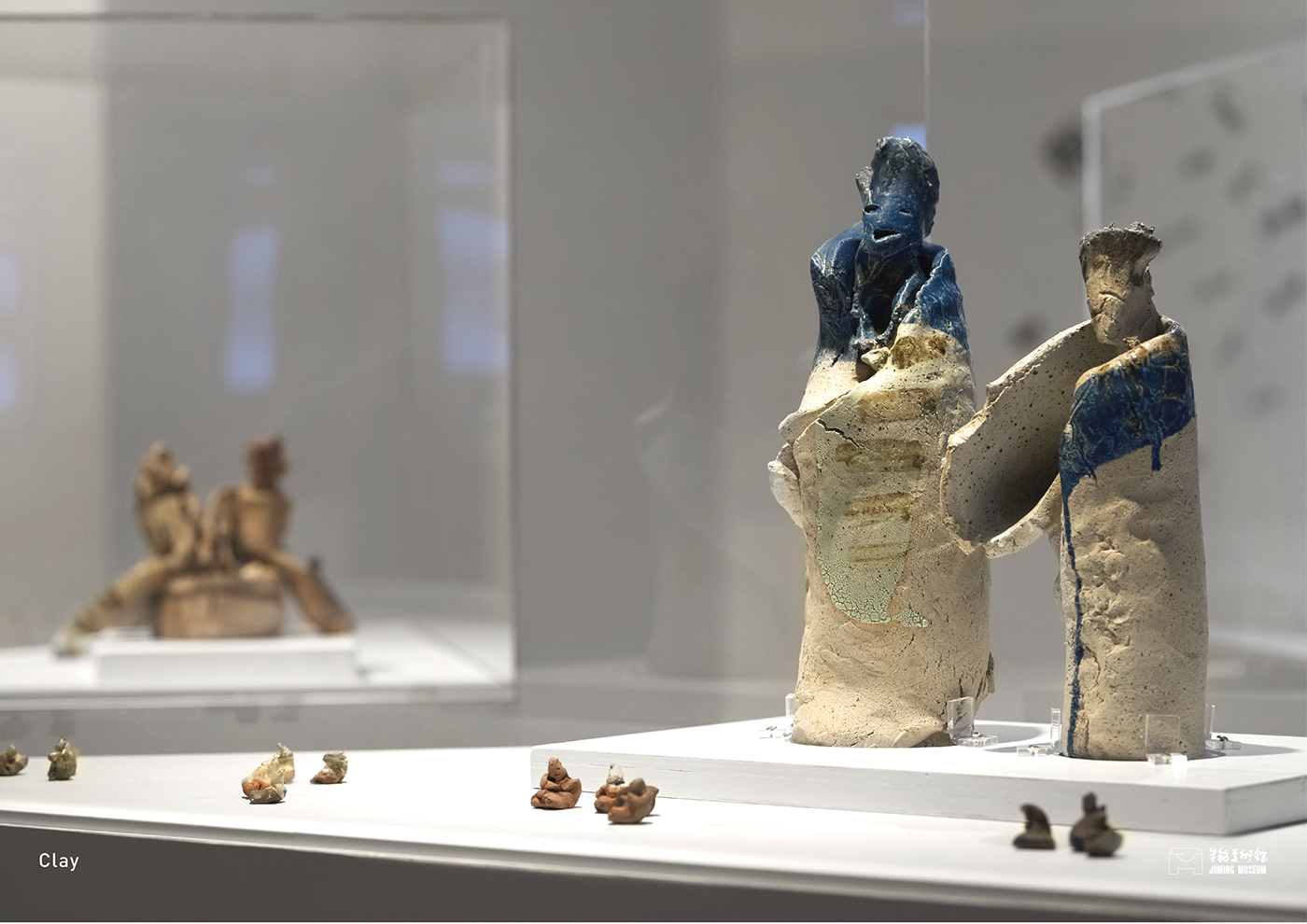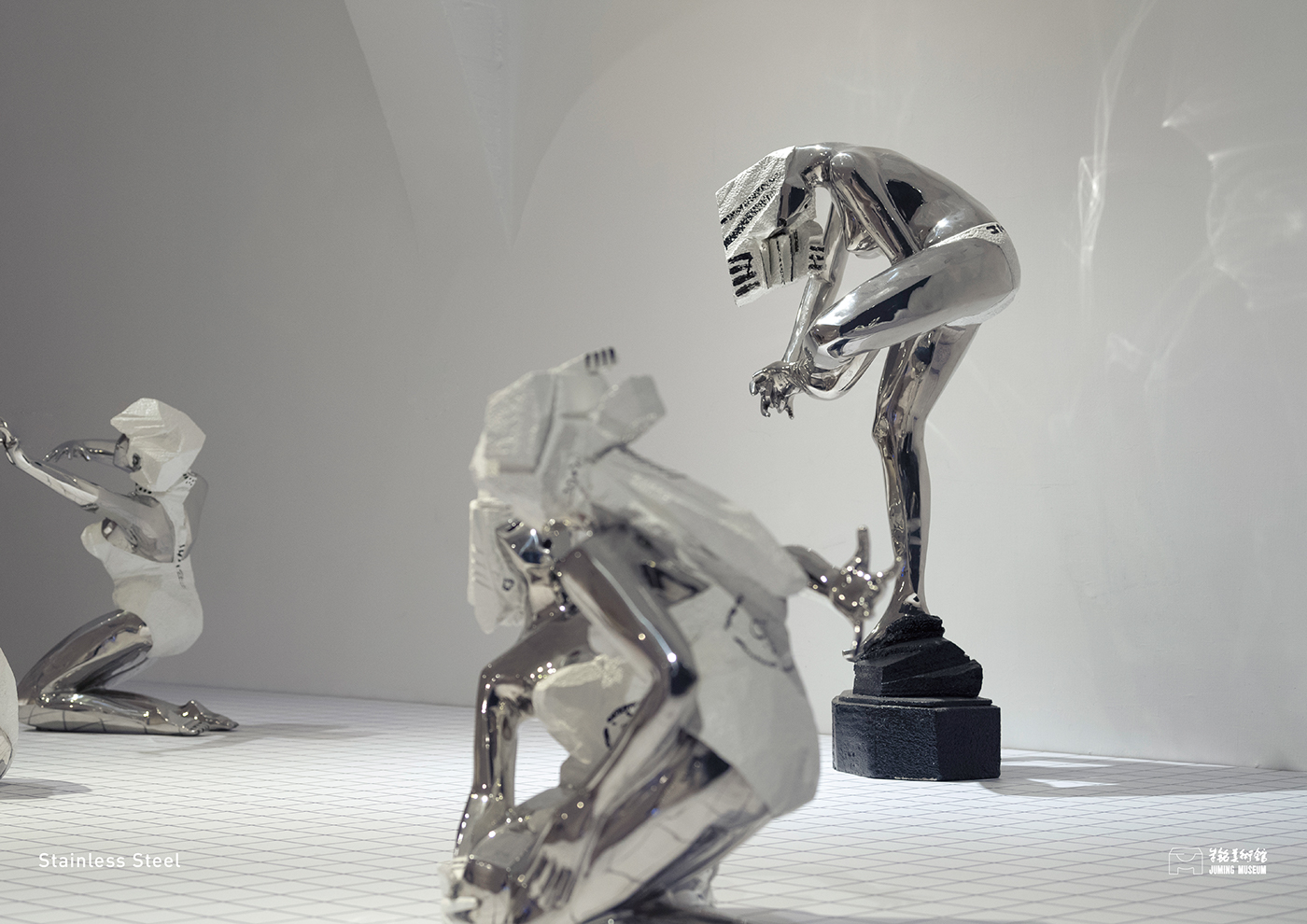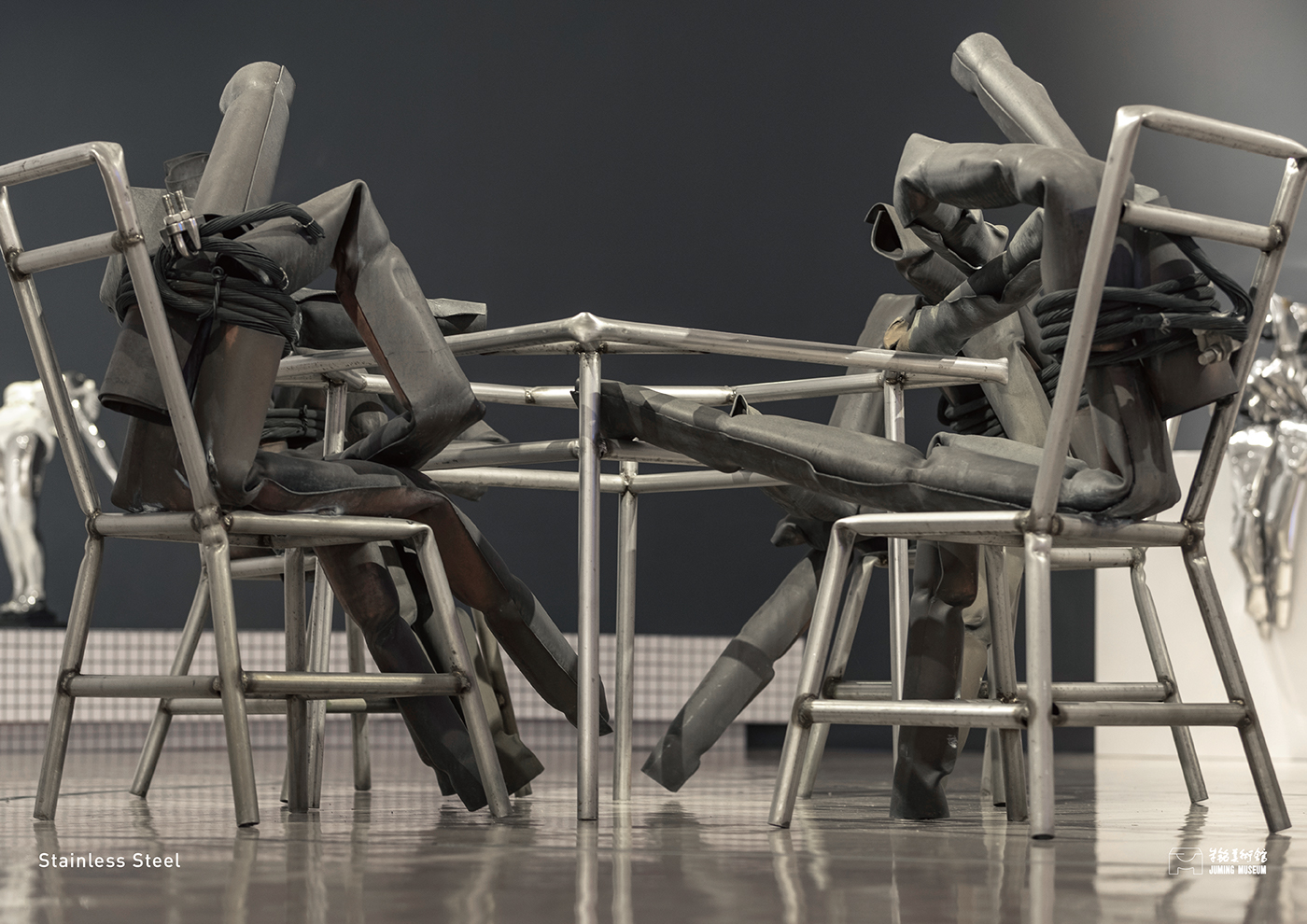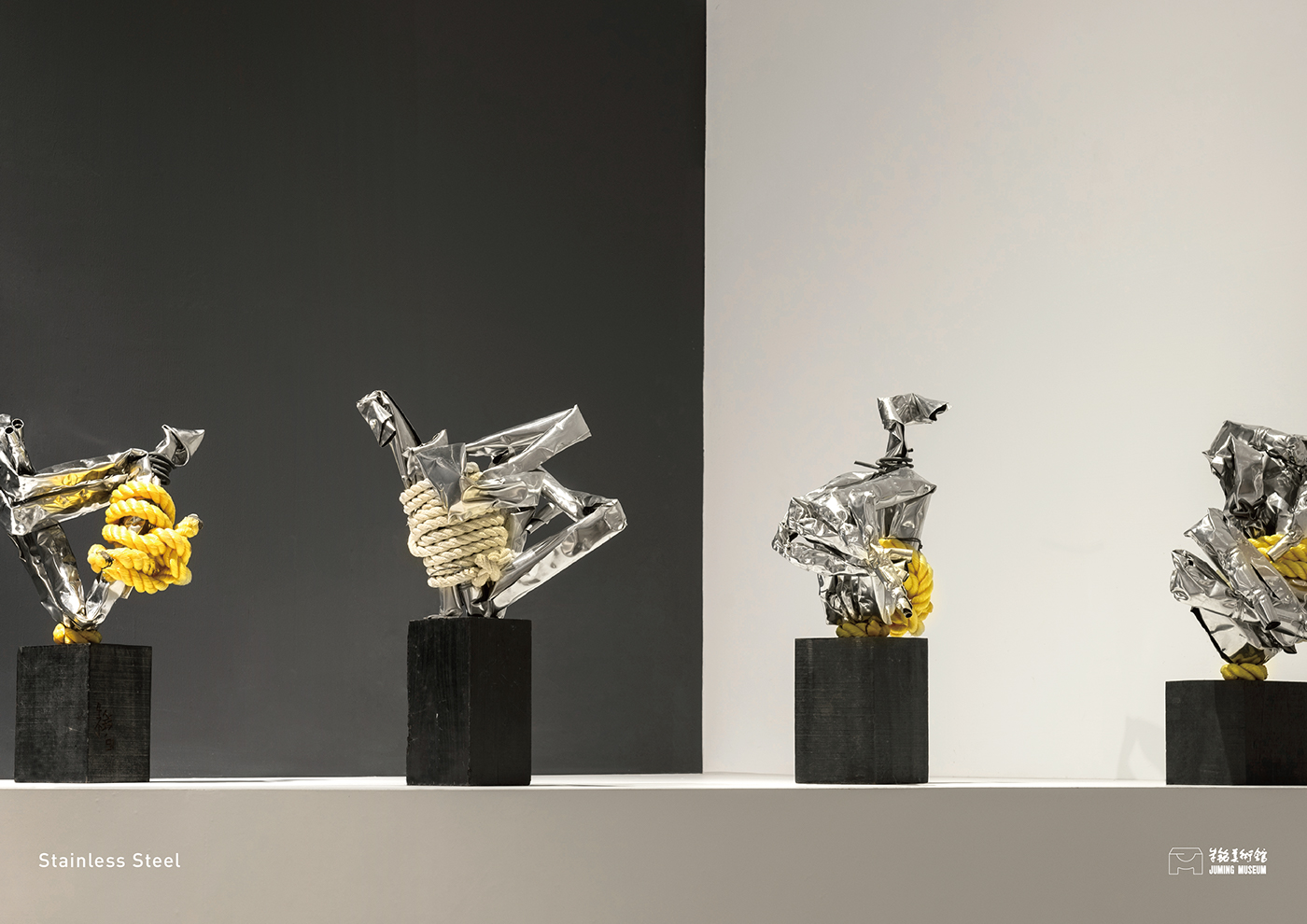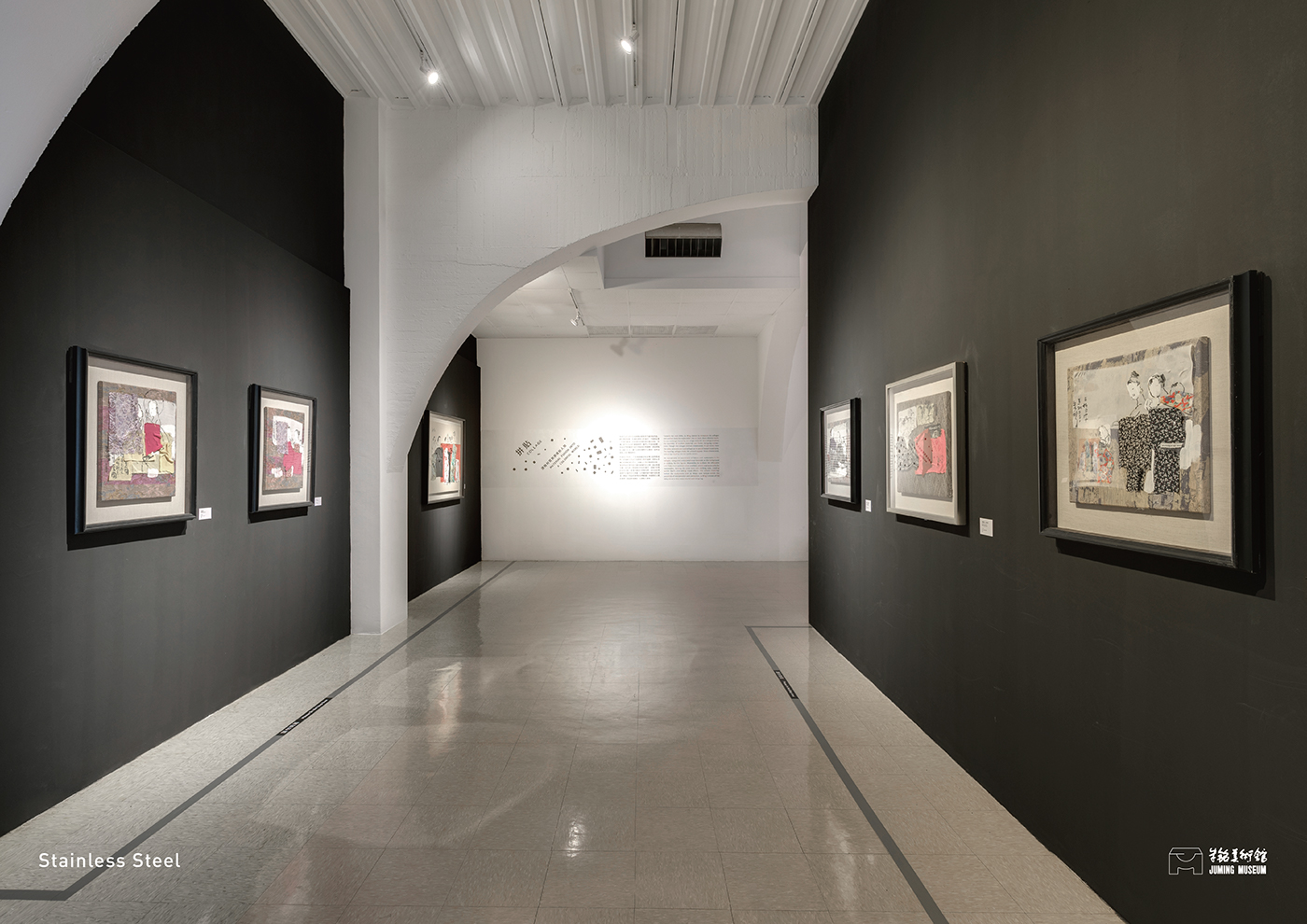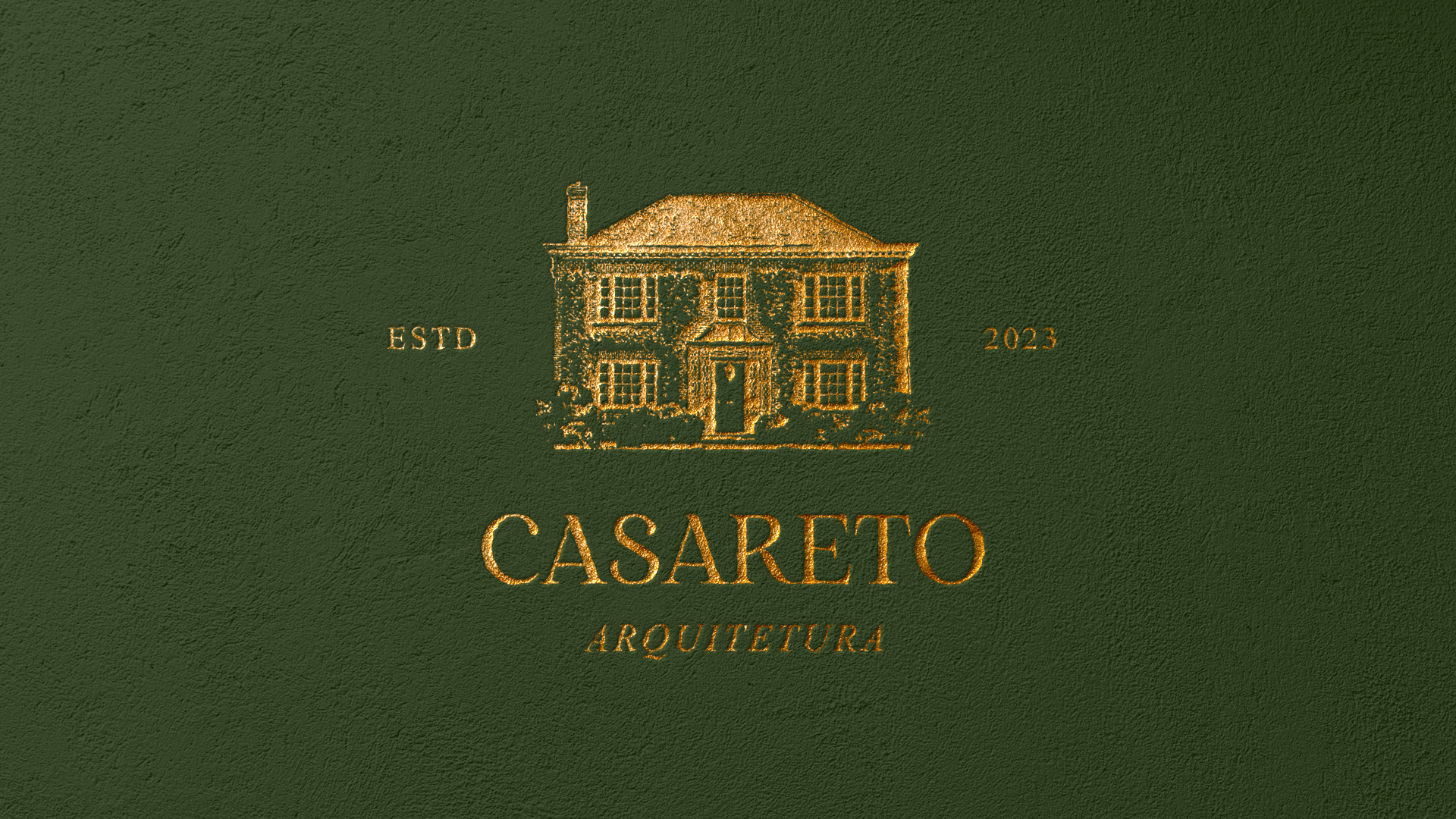2016年朱銘典藏展
2016 Exhibition of Ju Ming’s Collection
探材.拓藝
The Great Expedition
Exhibition planning & Visual deaign
Team / ◐◐◐同心圓設計
Designer / Ching Yi
Account executive / 詹威誠 Eason Chang
Client / 朱銘美術館
Date / 2016 October
---
展期:2016/11/26-2017/12/31
地點:朱銘美術館本館一樓
Team / ◐◐◐同心圓設計
Designer / Ching Yi
Account executive / 詹威誠 Eason Chang
Client / 朱銘美術館
Date / 2016 October
---
展期:2016/11/26-2017/12/31
地點:朱銘美術館本館一樓
---
這次很榮幸可以跟朱銘美術館合作,為了朱銘老師八十大壽策劃了回顧多年創作。一手包辦視覺部分以及展區規劃,最開心的莫過於館長以及朱銘老師本人大力稱讚,聽到時只能感動到跪下來痛哭流涕(ಥ﹏ಥ)。
這次展覽主軸為「探材 / 拓藝」,展區分為六大展區,分別展出朱銘老師創作歷程所用的六種材質。因此視覺部分以六種象徵材質的圖騰加上以「人」為中心概念,將「點、線、面」匯聚為本次展覽的創作主軸。視覺色彩部分以不同明度的灰加上大地色貫穿六種材質作為色彩延伸。
---
導論
Introduction
在朱銘的美學觀中,創新一直是其堅持的理念,從《鄉土系列》、《太極系列》到《人間系列》,從不因戀棧一個階段的成功,便駐足不前,總是勇於放下已知,邁入未知的挑戰。而嘗試不同的創作材料,則是他在作品主題外,求變的重要途徑。他總是不拘泥於一種材質,不斷挑戰各種材質的可能性,展現作為一位傑出藝術家的多元創造力,也成為其極具辨識性的特色。即將邁入八十歲的朱銘,從十五歲拜師雕刻師傅李金川學藝開始,至今已超過六十年的藝術生涯,仍持續創作不輟,時有新作,體現其「藝術即修行」的理念。
Innovation has always been Ju Ming’s conviction in his world of aesthetics. From the Nativist Series, Taichi Series to the Living World Series, he never indulged in success or stopped moving forward. Instead, he let go of what he had acquired and challenge the unknown. Aside from choosing different subjects, working with different mediums becomes his means of innovation. He is never bound by one particular material, but seeks the possibility of many, which is a sign of the array of his creativity and his distinct personal trait. Ju Ming started studying carving with the master, Lee Chin-Chuan at the age of 15, and now he is about to turn 80. His career in art spans over 60 years, and he is still charging forward, a true display of “art as a monastic practice.”
為回顧朱銘多元的創作歷程,本館策劃《探材.拓藝:2016年朱銘典藏展》,從其多次創新的元素-材質出發,以木-「雕」、陶-「塑」、海綿-「捆」、不鏽鋼-「捲」與「光澤感應用」、拼貼-「異材質組合」,六種創作方法下的六個不同系列作品,作為展覽子題,建構起一條朱銘在探材與拓藝下所體現的創造性軸線。「探材」不僅希望引領觀眾回顧朱銘令人驚艷的媒材探索成果,也能在作品材質的處理方式中,實際體會其美學觀;「拓藝」除了揭示朱銘由此所開拓的藝術範疇,更期待觀眾能夠藉由作品所體現的創作理念,拓展自身的藝術視野。
As a retrospective of Ju Ming’s diverse paths in art, Juming Museum presents The Great Expedition – 2016 Exhibition of Ju Ming’s Collection. The exhibition focuses on the core element of Ju Ming’s innovation – materials. It is developed into six subtopics, Wood – Carving, Clay – Sculpting, Sponge – Binding, Stainless Steel – Rolling and Lustering, and Collage – Composite Materials. Six creative approaches with six series of artworks form the common thread of Ju Ming’s material exploration and artistic extension. Material Exploration brings viewers not only a retrospective of the astounding artworks, but also his sense of aesthetics in how he approaches the materials. Artistic Extension reveals how Ju Ming has pushed forward his own artistic boundary, in anticipation that his creative philosophy will inspire the viewers to push forward their own.
---
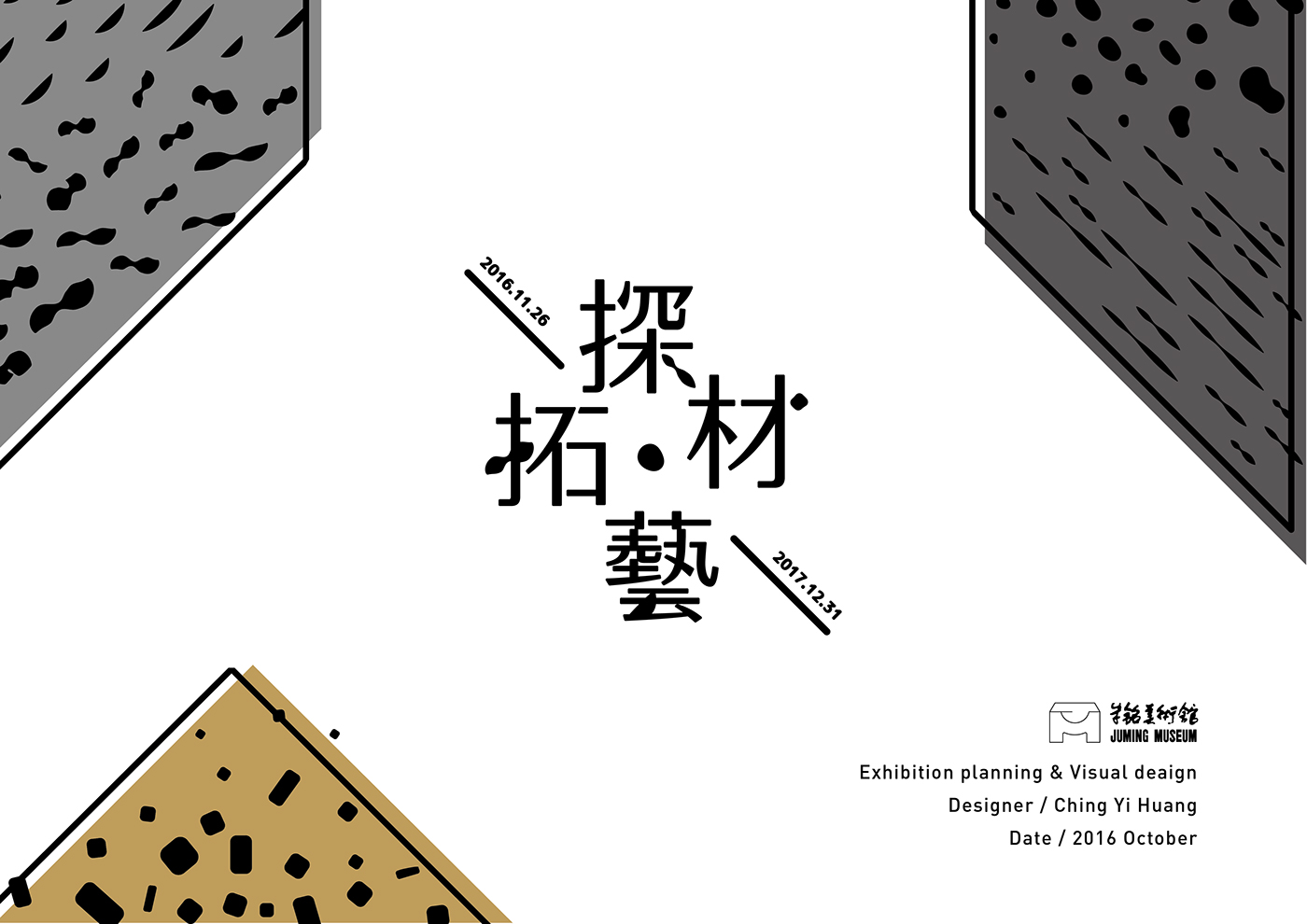
一、探材-縱手放意,無心而得
1. Material Exploration – Unhindered and Unintentional
對於朱銘而言,不同材質有其各自的本性。他不僅深入理解不同媒材的特性,更在此基礎上,一方面在作品中留下創作的痕跡,一方面讓材質本身成為營造作品表現力的重要元素。他既順從個人內在的本性,也隨順材料的天性,自言創作是「縱手放意,無心而得」,不被既定的形式所束縛,以速度擺脫理性的思維,讓真我主導創作,直接與材料交流及互動,將作品的完成,凝結在材質最能傳神的一刻。
To Ju Ming, each material has its own property, and he delves deeply into it. Building upon that, he leaves traces of his marks while making the material a key in presenting the artwork. He follows his own nature as well as that of the material, and once said that creating art is “unhindered and unintentional”. Not bound by existing forms, he deviates from rational thinking with speed, allowing the true nature to take over and interact with the materials directly. The completed artwork captures the moment when the very essence of the material shines through.
其中,他以縱手操作偶然,使材料在放意中,超越原定的設想,再讓真我取捨,留下的便是屬於藝術家個人的獨特風格。這不僅訴求著藝術家對於材質的高度掌控技藝,能夠順著材料的本性與變化而隨機應變,也體現了朱銘順其自然的態度,既與中國道家哲理中「道法自然」與「無為」的思想共鳴,也與西方現代主義美學中注重材質本身特性的概念不謀而合。
During the process, Ju Ming let go, allowing chance to take the materials beyond the confines of original assumptions. The true nature takes over, retaining the style that is the artist’s own. This shows his masterful grasp of the material and his ability to morph with the nature of and changes in the material. He goes with the flow, echoing the Taoist philosophy of “the way is derived from nature”, and “inaction”, and resonating with Western Modernism, which focuses on the property of the material itself.
二、拓藝-多元材質,創藝視野
2. Artistic Extension – A Grand Expedition with Multiple Materials
本次展覽以木-「雕」、陶-「塑」、海綿-「捆」、不鏽鋼-「捲」與「光澤感應用」、拼貼-「異材質組合」,六種創作方法下的六個不同系列作品,作為展覽子題。從連貫朱銘藝術歷程的木雕揭開序幕,呈現其快速刀法下,粗獷概括卻能掌握作品神韻的造形方式。再連結到陶塑,標誌了朱銘不以「雕」這項令其成名的技法自滿,藉由陶土的可塑性,改以「塑」重建藝術語彙。海綿則是他探究可塑性材質的另一項成果,透過捆綁,突顯材質本身的彈性與活力,並成為組構人物的特色。
This exhibition features six creative approaches with six series as the subtopics, Wood – Carving, Clay – Sculpting, Sponge – Binding, Stainless Steel – Rolling and Lustering, and Collage – Composite Materials, starting with wood sculpture, a consistent theme throughout Ju Ming’s career. His rapid knife work, though rugged and imprecise, fully captures the spirits within the form. However, Ju Ming did not linger over wood carving, a skill he had mastered. He moved on to ceramics and reinvented the artistic lexicon associated with sculpting. With sponge, he explored a different side of its plasticity, featuring the elasticity and energy by binding the materials as key features of the human figures.
而以捲捆不鏽鋼片再組裝而成的「捲片人」系列作品,進一步挑戰了「捆」的技法,呈現出剛硬和柔軟並存的視覺張力,開創了不鏽鋼人物雕塑的嶄新風貌。同為不鏽鋼材質的《人間系列-游泳》,充分發揮了材質表面燦亮光澤的特性,形塑出身著泳裝的女孩們光滑的肌膚質感與俐落的身體曲線。在平面拼貼作品中,則不侷限於單一材質的處理,而是運用多樣材質的組合,開展出更令人玩味的觀看聯想。
The Stainless Steel Man series involves rolling, binding and assembling the stainless steel sheets into human forms. It took the “binding” technique one step further. The visual tension, where rigidity and suppleness coexist, started a brand new era for stainless steel body sculptures. The Living World Series – Swimming, which also employs stainless steel as the medium, fully exploits its luster and sleekness to create the silky skin and sophisticated curves of girls in swimsuits. For the collage, Ju Ming moves beyond single material, and creates many intriguing possibilities with composite materials.
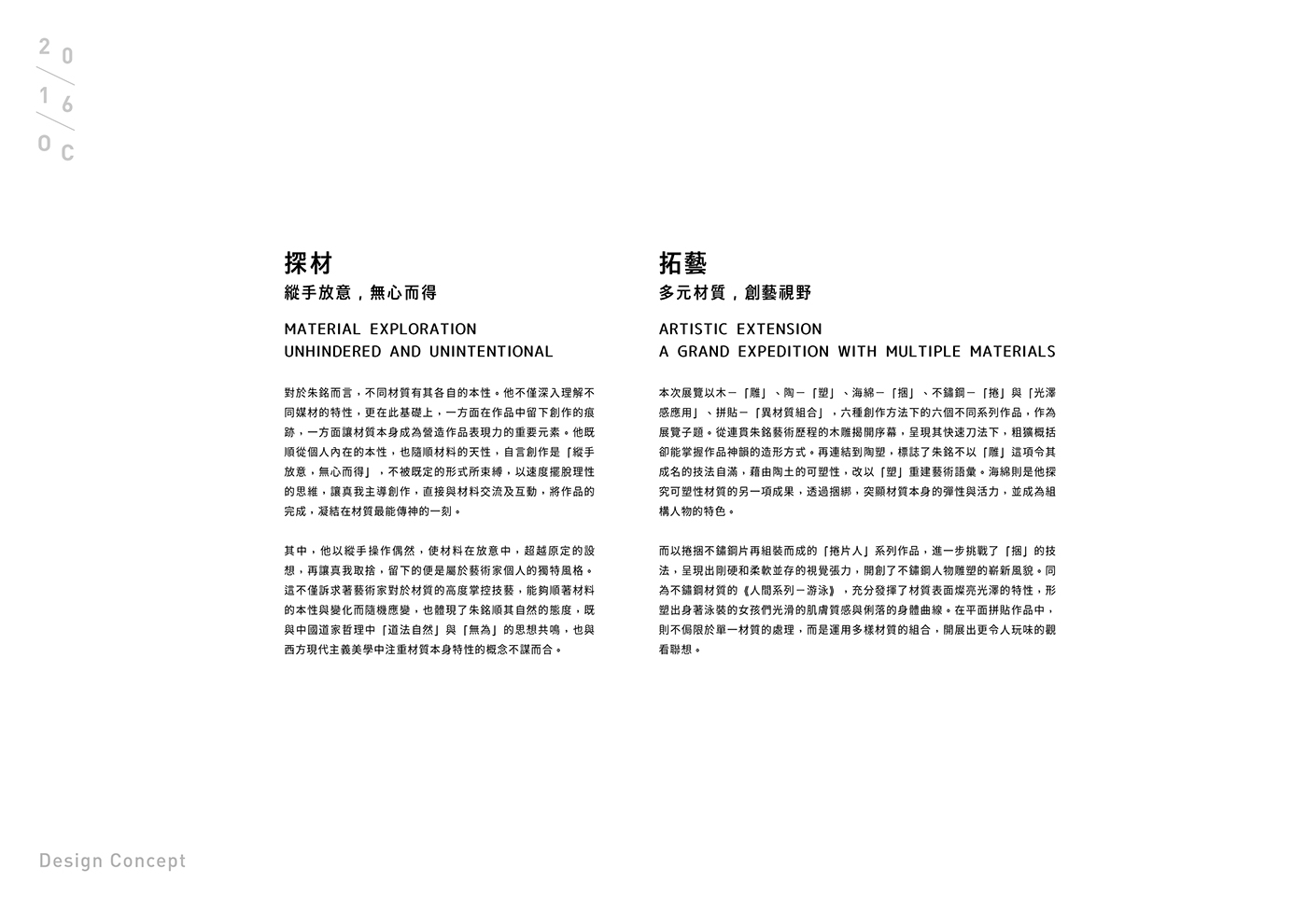
Ⅰ. 木-快速刀法雕刻形象神韻
I. Wood – Capturing the essence with rapid knife work
木雕在朱銘的創作歷程中,扮演了關鍵的角色,不僅是他學藝的開始,也連貫了各個時期的創作,其造形語彙並體現與影響在他不同材質的作品上,尤其延續在保麗龍翻銅與石雕的作品當中。從1970年代的《鄉土系列》,朱銘逐漸建立起個人的木雕風格,創作上省去細節,透過快速刀法,以粗胚般概括粗獷的外形把握作品神韻。
Wood carving plays a vital role in Ju Ming’s career. Not only does it mark the beginning of his path in art, it is also a critical element that links the various stages in his career. The creative lexicon is exemplified in and influenced by works of other mediums, especially the stone sculptures and bronze casting of his Styrofoam works. In the 1970s, Ju Ming gradually solidified his personal style in wood sculpture with the Nativist Series. He minimized the details, encapsulating the essence of the artwork in the rugged form with rapid knife works.
在《太極系列》中,加重作品的塊面感與抽象性,藉此捕捉太極的意境。這樣的表達也延續至1980年代開始發展的《人間系列》,呈現簡約、重神似的人物形象,再結合彩繪來修飾與形容,表現朱銘對於人間百態的觀察與體悟。至2007年,朱銘逐漸將木雕的色彩予以簡化,先是只敷上白與黑色,至2012年的《人間系列-市民》,更完全回歸木質原色,使得材質更直接被看見,藝術家創作的痕跡也更鮮明流露,體現其創作觀念的轉變。
In Taichi Series, Ju Ming emphasizes the blocks and abstraction to capture the spirit of Taichi. Such style is extended into the 1980s with the Living World Series. The simplified human forms with likeness in spirit are combined with color embellishment to delineate Ju Ming’s observation and understanding of the living world. In 2007, he simplified yet again the colors on the wood sculptures by using black and white only. In 2012, the Living World Series – Citizens, he returned to the bare wood tone, making the texture of the material and traces of Ju Ming’s marks even more noticeable, and the transition in his creative philosophy evident.

Ⅱ. 陶-率性之手捏塑樸實人間
II. Clay – Sculpting a living world with the touch of hand
朱銘於1970年代後期,開始以陶土作為創作媒材,可視為其探索材質可能性的重要起點之一。首先,他以此離開了嫺熟的「雕」與「刻」,而是運用陶土本質的「可塑性」,直接以雙手為工具,重塑藝術語彙。其次,也是陶土帶給他靈感,讓他轉而嘗試海綿與不鏽鋼創作。
Ju Ming started working with clay towards the late 1970s, which is considered an important beginning of his material exploration. First, he departed from the familiar territory – carving. He turned to the plasticity of clay, reconstructing the artistic lexicon with his own hands. In addition, it was clay that inspired him to work with sponge and stainless steel later on.
有別於傳統陶塑經由拉坯或泥條的過程來塑形,朱銘隨意把陶土擀平,或將陶土板捲起和翻折,或快速地捏、扭、拍、黏,形塑出一件件造形多樣的人物、魚隻、家禽和家畜作品。同時,他刻意不修飾這些創作的表面,使其在燒製後留下些裂紋和粗粒,在施釉上也打破常規,以上釉和不上釉並用的方式,營造多變的肌理效果,突顯陶土樸實的韻味和質感,並與所要表現的人間主題在精神上互相呼應。
Different from making traditional ceramics, which involves hand throwing or clay coils, Ju Ming rolls the clay flat. He rolls up or folds the flattened clay, creating humans, fish, poultry and livestock with various hand maneuvers. Meanwhile, he purposely leaves the surface unrefined, making the piece prone to cracks and coarse texture after firing. He often thinks outside the box, leaving a piece with both glazed and unglazed surface to create various textures and emphasize the unadorned feel, which echoes the spirit of the living world that Ju Ming intends.
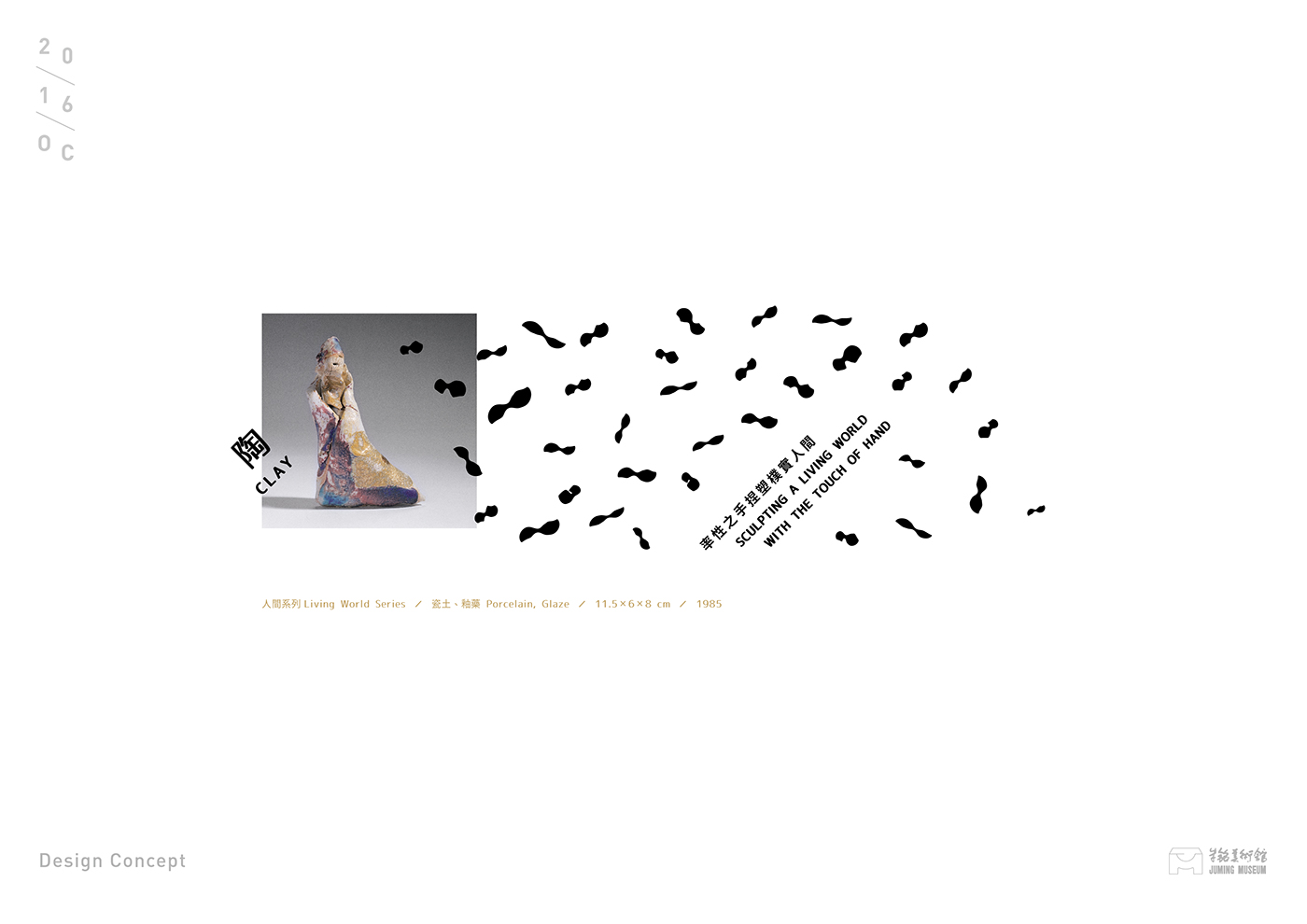
Ⅲ. 海綿-彈力材質擬仿運動人體
III. Sponge – Mimicking human bodies in motion with elasticity
對於可塑性材質的探究,卻又不想侷限在陶土作品的有限尺寸,促使朱銘於1980年代後期,尋找另一種同樣具備高度可塑性,並且質軟和容易成形的材料。海綿於是成為他的新發現,除了帶有陶土般可以捏塑的柔軟特質,更富有自主的彈性,被揉捏和彎折後,一放鬆便立即彈回原樣。
Wanting to explore materials with plasticity beyond the size limit of ceramics, Ju Ming started to search for a substitute that is both soft and plastic in the late 1980s. He found sponge, a material as supple and moldable as clay but even more elastic, always returning to its original shape even after bending and kneading.
朱銘利用海綿的這種本性,以麻繩或鐵絲將其捆綁定形,又使得海綿在加壓下,形成膨脹的球狀,既突顯材質本身的活力,也讓創作者的藝術原創,化入材質當中。由於朱銘以捆綁後成為球體的海綿,作為組構人體的造形語彙,彷彿運動員身體肌肉般的效果,因此多用於運動員系列的作品上,並將海綿翻銅,使成品留下翻模的模線、海綿的顆粒和麻繩捆綁的痕跡,或於其上敷色,豐富了作品表面的材質肌理。
Ju Ming takes advantage of this quality by binding the sponge with ropes and steel wires. The sponge bulges into a bulbous form, enlivening the material with energy and originality. The bound sponges resemble an athlete’s muscles when used as part of the human figures. Therefore, when many of the artworks from the athlete series were cast in bronze, the granulated texture, and traces of the seam and the ropes used to bind the sponge are preserved. Sometimes, colors are applied to enrich the texture.
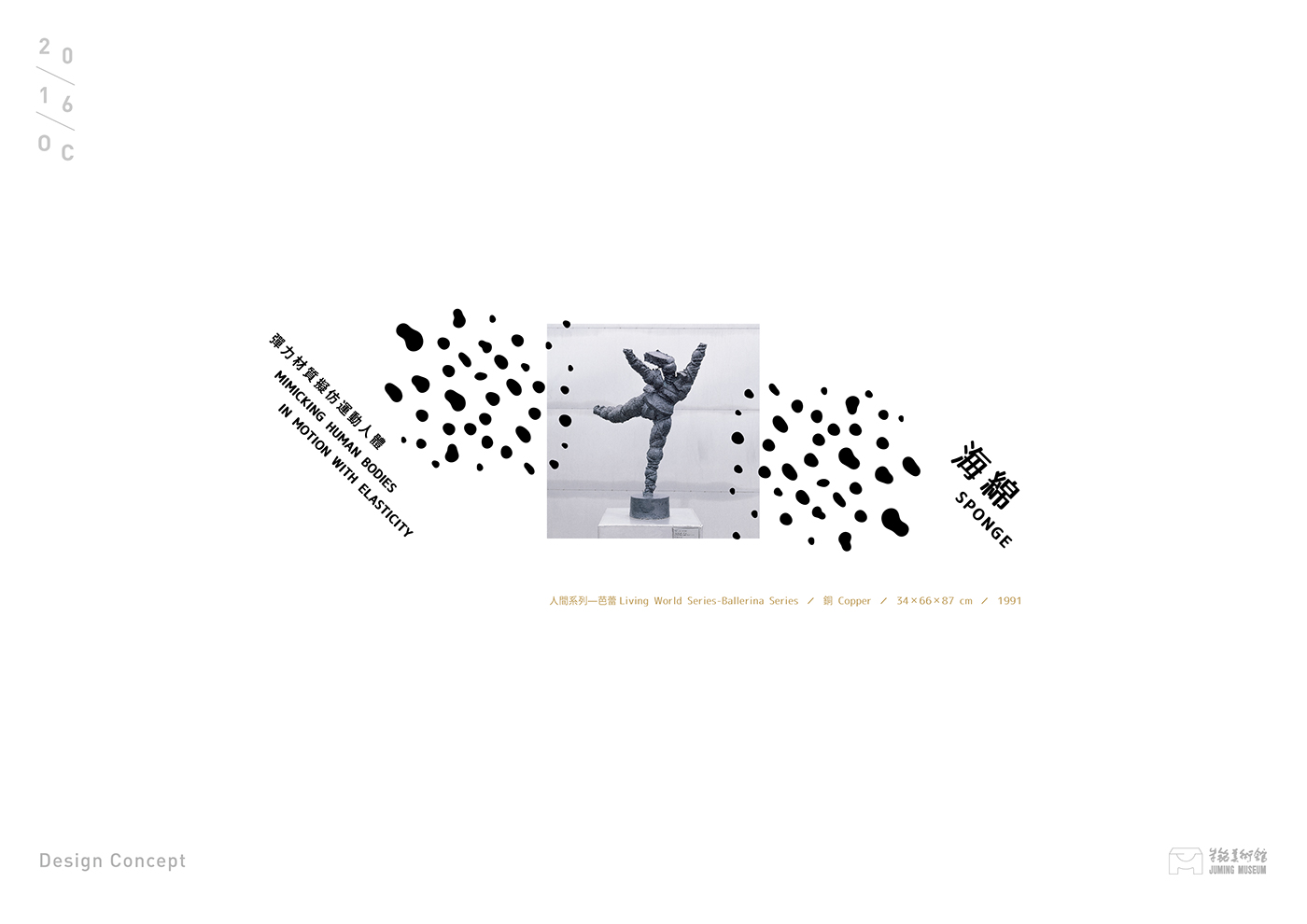
Ⅳ. 不鏽鋼-挑戰捆技開創鋼雕新貌
IV. Stainless Steel – Binding the new face of steel sculpture
僅捆綁可塑性高的海綿,不能滿足朱銘對於媒材的實驗精神。為了挑戰「捆」的技法,他選擇了剛強堅韌的不鏽鋼,於1990年代初期發展出「捲片人」系列雕塑。面對此一人力難以塑形的材質,他特別請藝術家友人,設計出能夠協助他捲捆不鏽鋼片的機器,以此將其捲成大小和形狀不一的圓管狀後,再以焊接進行組裝,成為姿態各異的人物雕塑。
Simply binding the highly plastic sponge did not quench Ju Ming’s thirst for experimenting with different mediums. To push the boundary of binding further, he chose the highly rigid stainless steel and developed the Stainless Steel Man series. The rigidity of such material cannot be manipulated manually, and therefore, he invited a fellow artist to design machines that help him roll and bundle the stainless steel. After rolling the metal sheets into tubes of various sizes, he welded them into human figures with different poses.
這些作品既保留了不鏽鋼片光滑冰冷的表面,又利用其可被捆扭的延展性,呈現出剛硬和柔軟並存的視覺張力,並於其上纏繞線條作為裝飾,同時賦予較為誇張的人物姿態,以活化材質本身的剛硬和冰冷,體現出藝術家對於材質的掌握與巧思,也開創了不鏽鋼人物雕塑的嶄新風貌。
The cold and sleek surface and its ductility create the visual tension where rigidity and suppleness coexist. Coiled with wires and ropes, the figures are given exaggerated poses to vitalize the coldness and stiffness of the material itself. His ingenuity and understanding of the material shine through, giving stainless steel body sculpture a brand new presence.
--
Ⅴ. 不鏽鋼-燦亮光澤輝映泳者體感
V. Stainless Steel – Shining over swimmer physique
如果說捲片人藉由捆捲不鏽鋼片的方式,呈現出剛硬材質被擠壓彎捆後的力量痕跡與材質質感,那麼朱銘於2008年開始發表的《人間系列-游泳》,則是就不鏽鋼表面燦亮光澤的特性,予以充分發揮,形塑出身著泳裝的女孩們光滑細緻的肌膚質感與優雅俐落的身體曲線。
While the stainless steel man shows the effects of force on and texture of a rigid material being pressed, bent and bundled, Ju Ming’s the Living World Series – Swimming in 2008 fully exploits the luster and glow on the stainless steel surface. Its glossy surface perfectly morphs into the silky skin and elegant, sophisticated curves of girls in swimsuits.
創作時,朱銘先以保麗龍雕刻,再翻模為不鏽鋼,並透過拋光技術,將作品的臉、手與腳等光滑部位,打磨出反光度極高的亮面效果,並刻意保留保麗龍顆粒粗糙質感的頭髮與泳裝等部位,更襯托女孩肌膚的光亮,彷若剛從泳池離開般,仍漾著池水披覆下的晶瑩色澤。這使得作品雖無表現游泳的動作,卻依然呼應「游泳」主題,刻劃出女孩們在游泳池畔的各種姿態,或拉筋伸展,或作日光浴,在較為靜謐的氛圍下,讓人物體感的細節得以充分被看見。
When creating the piece, Ju Ming carved the Styrofoam and cast it in stainless steel. He then polished the face, hands and feet, making them glossy and highly reflective. The hair and swimsuits retain the rough and granulated texture of Styrofoam to set off the girls’ radiant skin. Their bodies glow with water, as if they just left the swimming pool. Though the act of swimming is not actually depicted, the sculpture echoes the theme, swimming, by presenting various postures by the pool. Some are stretching and some sunbathing. Details on the figures are clearly visible against a placid backdrop.
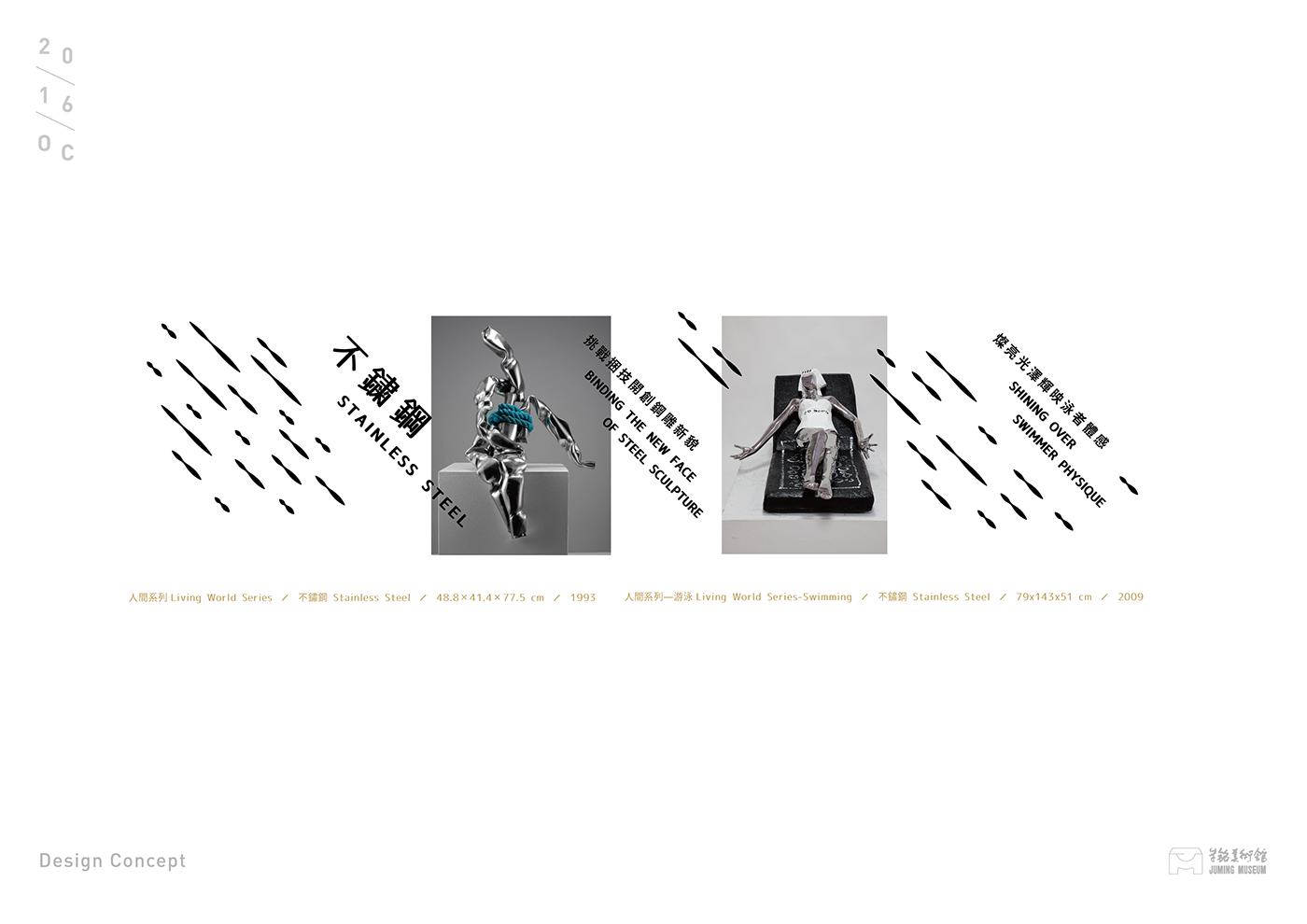
Ⅵ. 拼貼-匯融材質開展繽紛人間
VI. Collage – Material fusion into a colorful world
朱銘於1990年代中期開始發表的平面拼貼作品,將材質的探索,拓展到更多元的操作,不侷限在單一材質的處理,而是運用多樣材質的組合拼貼,形構出更令人玩味的觀看聯想。雖然以平面為基礎,朱銘依然將雕塑的創作思維與空間邏輯,透過拼貼和堆疊的手法,讓作品更具實際的立體感,延伸出視覺以外的觸覺感受。
Towards the mid-1990s, Ju Ming started to introduce his collages and pushed material exploration into an even more diverse realm. He was no longer bound by any single material. His collage involves the assembly of multiple materials and forms intriguing connections. Though the collages are two-dimensional, he perceives them the same rationale and spatial logic as he would toward sculptures. The layering collages made the artwork appear three-dimensional, extending visuality into the tactile senses.
他將各式布料,乃至報章雜誌和宣傳文宣等現成物,直接納入作品的背景或人物的服飾,同時以手繪的寫意線條和色彩,描繪出人物的輪廓和身影,使得現成的物件和手繪的線條色彩之間,彼此穿插交疊,或代表人物服飾的色彩和樣式,或暗示空間的前後深度,或增添畫面的視覺效果,並以這些現成物件自身的文化意義,以及藝術家手繪的造形語言,豐富了作品的聯想與詮釋範圍。朱銘對於人間的再現,因此更為繽紛,也更耐人尋味。
He incorporates an assortment of fabrics and readymades in his collages, using print and promotional materials as the background or clothing for the figures. Meanwhile, he outlines the silhouette with freely hand-painted colors and lines, which intertwine with the readymades, forming the color tone and clothing style, creating spatial depth, and adding visual effects. The cultural meanings behind the readymades and Ju Ming’s own lexicon enrich the possibility of interpretation and connection. Ju Ming’s version of the living world is thus more colorful and intriguing.
